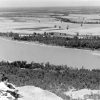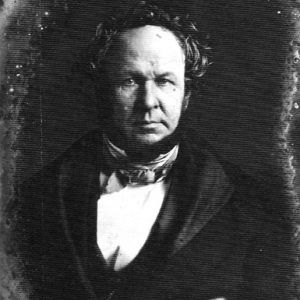calsfoundation@cals.org
Henry Rowe Schoolcraft (1793–1864)
Henry Rowe Schoolcraft published the first written description of the Arkansas Ozarks’ geography, vegetation, wildlife, and inhabitants. His Journal of a Tour into the Interior of Missouri and Arkansaw, published in London, England, in 1821, is an account of a three-month exploration by Schoolcraft and one companion, Levi Pettibone. From November 1818 to February 1819, Schoolcraft explored land from Potosi, Missouri, southwest to the White River, northwest to near Springfield, Missouri, then south by canoe on the White River to present-day Batesville (Independence County), and finally northeast again to Missouri.
Schoolcraft’s great-grandfather was a British soldier in New York in the early 1700s who settled with a German wife in Schoharie County, New York. His son John served in the French and Indian War, and his grandson Lawrence, Henry’s father, fought in the American Revolution, later taking up glass manufacturing.
Henry Rowe Schoolcraft was born in Guilderland, New York, near Albany, on March 28, 1793, and was a studious boy interested in geology, literature, art, and languages. He briefly attended Union College and studied chemistry and mineralogy at Middlebury College in Vermont. After working in several glassworks factories, his interest in geology and financial prospects led him west to explore the mineral deposits of Missouri, and in 1819, he published View of the Lead Mines of Missouri. The book was the first book published on Western mining in the United States, and Schoolcraft enthusiastically offered information about the potential for lead mining in Missouri. He also described U.S. mining methods and recommended establishment of a mining school to teach new European mining techniques. Today, Missouri is the number one producer of lead in the United States.
Schoolcraft’s Journal introduced some of the early European settlers of the Missouri and Arkansas Ozarks, those who lived by hunting and trading with the Osage Indians and built their own meager homes in the wilderness. Schoolcraft and Pettibone had walked off into the woods without adequate supplies, without guns for hunting deer or bear, and without clear direction. As novice explorers, they suffered several setbacks: loss of their horse and other supplies, hunger, wet clothing, and encounters with bears and other wildlife. More than once, they were simply lost in the woods. Schoolcraft’s spirit of exploration and his determination to keep a journal, however, were worthwhile, as he interested his own contemporaries in the potential for settlement of the area. But he described the land as sterile: “Nothing can exceed the roughness and sterility of the country… and the endless succession of steep declivities, and broken, rocky precipices….”
Schoolcraft was grateful for the hospitality shown by lone hunters or by families (Wells, M’Gary, Coker, Holt, and Fisher are mentioned by name) who took him in and shared what they had. However, he was judgmental about their lack of education or religious training, what he called “witchcraft,” the dirt-floored cabins, greasy clothing, unkempt appearance, and the “truly deplorable” state of the people.
His work brought some personal notice, and Schoolcraft later became an Indian agent to the Upper Great Lakes tribes and was a key figure in negotiations to turn over millions of Indian acres to the United States. In 1823, he married Jane Johnston, a part Ojibwa Indian who, with her mother, recounted and compiled many oral tales from Indian lore. He became an ethnologist, Indian historian, and expert on Native American languages and customs. His recounting of one Indian legend in Algic Researches inspired Henry W. Longfellow’s popular poem, The Song of Hiawatha. As an explorer, Schoolcraft determined the source of the Mississippi River at Lake Itasca in northern Minnesota in 1832.
After moving to Washington DC in 1847, Schoolcraft suffered a paralytic stroke and lived out his later years as an invalid whose health steadily deteriorated. His major work, written with the physical help of his second wife, Mary Howard Schoolcraft, is his six-volume Historical and Statistical Information Respecting the History, Condition and Prospects of the Indian Tribes of the United States. He died at age seventy-one on December 10, 1864. Today, he is best known as an early American anthropologist, the first to take up Native American studies and to spread interest in Indian history and culture. Schoolcraft’s extensive papers are held at the Library of Congress.
For additional information:
Bremer, Richard G. Indian Agent and Wilderness Scholar: The Life of Henry Rowe Schoolcraft. Mt. Pleasant, MI: Clarke Historical Library, Central Michigan University, 1987.
“Henry Rowe Schoolcraft.” The International Magazine of Literature, Art, and Science 3 (June 1851): 300–303.
Henry Rowe Schoolcraft Papers, 1788–1941. Library of Congress, Washington DC.
Milson, Andrew J. Arkansas Travelers: Geographies of Exploration and Perception, 1804–1834. Fayetteville: University of Arkansas Press, 2019.
Schoolcraft, Henry Rowe. Journal of a Tour into the Interior of Missouri and Arkansaw. London: Sir Richard Phillips and Co., 1821.
———. Rude Pursuits and Rugged Peaks: Schoolcraft’s Ozark Journal 1818–1819. Edited by Milton D. Rafferty. Fayetteville: University of Arkansas Press, 1996.
Linda Lovell
Northwest Arkansas Community College





 Henry Schoolcraft
Henry Schoolcraft 




Comments
No comments on this entry yet.